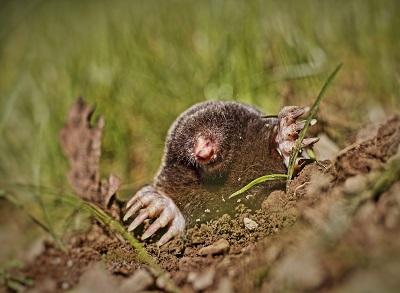
Expert Solutions
Even though moles are rarely seen, their impact on landscaping is hard to miss. Dying plants, mounds of bare dirt, and lawns disfigured by burrows are all signs a mole has set up shop.
North America is home to three species of this common pest. The eastern mole is the most widespread, named for its range east of the Rocky Mountains. The star-nosed mole lives in the eastern states, occupying land from Nova Scotia all the way to Florida along with parts of the Midwest. The third species is the hairy-tailed mole, which lives in some of the north-eastern states down into parts of Tennessee and North Carolina.
Moles are often lumped together with rodents, but they’re more closely related to hedgehogs and bats. This confusion comes in part because they’re commonly confused with voles, a rodent with similar habits. However, there are a few key differences between the two animals.
Most notably, moles have tiny eyes, long noses, and large shovel-like feet, while voles have blunt noses, bigger eyes, and round bodies. Voles also leave their burrows enough to create small, beaten tracks outside them. This is completely unlike moles, which only leave their burrows when absolutely necessary.
The Unseen Obstacles: Dealing with Unexpected Structural Challenges
Another misconception about moles is that they eat plant roots, but moles are insectivores. A mole eats between 50 to 100% of its body weight in worms each day, along with grubs and any other insects they can find. Moles can starve in a matter of hours, which is why they dig roughly 150 feet each day while searching for their next meal.
Translating Technical Jargon: Mastering Client Communication
All that digging can cause problems for landowners, which is where pest control experts come in.
There are two ways to address a mole problem: exclusion and control.
Mole exclusion is challenging because they burrow. Underground fences made from wire mesh can be used to protect small, high value areas, like gardens and flower beds. Similarly, wire mesh installed underneath a compost pile can limit a mole’s access to all the food sources living inside.
That said, both exclusion methods can take a lot of effort to set up and are better viewed as deterrents.
Also, remember there is no scientific basis for chemical or electronic mole deterrents. Home remedies are little more than a wish, and electronic devices meant to scare moles aren’t proven to be effective. Mole repellents containing castor oil, such as Tomcat® Mole & Gopher Repellent Granules, may keep moles away, but they’re best used alongside a plan to control existing mole populations.
However, there are a few effective ways to get rid of moles.
Bell Labs’ TALPIRID® Mole Bait is first and only registered mole bait proven to kill wild moles*. The bait mimics a mole diet staple – the earthworm, and moles can consume a lethal dose in a single feeding. The bait is easy to apply. Place it in an active burrow through a probe hole and check back several days later to see if the burrow is still active. If it is, simply reapply.
Pest control technicians can shore up their mole control plan with TALPIRID® Mole Traps. These durable traps are designed to be safe and easy to use, and set-up is entirely hands-free. Put the traps on active mole tunnels and wait. The trap’s yellow foot pedal will spring up to show when a mole has been caught.
Though moles can be destructive, TALPIRID products are an excellent way to make sure properties stay beautiful and mole-free.
To learn more about TALPIRID, contact your local Bell Laboratories representative. TALPIRID products can also be bought on Target Specialty Products’ online store.
*TALPIRID Mole Bait is the first and only mole bait registered with the Environmental Protection Agency using proven laboratory results.

